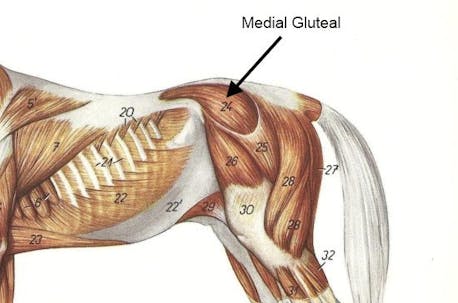what is the medial gluteal?
gluteus medius (GM) is the largest muscle of the horse, its main movement function is the extension of the hip joint. In the unloaded limb GM contraction swings the limb towards caudal for e.g. kicking out and in the weight bearing limb it pushes the body mass forward during locomotion.
The medial gluteal muscle is present in horses and plays an important role in their locomotion. It is one of the three gluteal muscles, along with the superficial gluteal and deep gluteal muscles, that are responsible for movement and stabilisation of the horse's hind limb.
Here are some key points about the medial gluteal muscle in horses:
Location:
- The medial gluteal muscle is located on the lateral aspect (outside) of the horse's hindquarters. It is positioned deep to the superficial gluteal muscle.
Origin and Insertion:
- The medial gluteal muscle originates from the ilium, which is one of the bones of the pelvis. Specifically, it arises from the crest of the ilium and the adjacent part of the sacrum. It then inserts onto the greater trochanter of the femur, which is the large bony prominence on the upper part of the hind leg bone.
Function:
- The main function of the medial gluteal muscle is to extend the hip joint and abduct the hind limb. It works in conjunction with other muscles to provide power and propulsion during movements such as walking, trotting, and galloping.
Innervation:
- The medial gluteal muscle is innervated by the cranial gluteal nerve, which arises from the sacral plexus. The nerve carries motor signals from the spinal cord to the muscle, enabling its contraction and control.
It's worth noting that the gluteal muscles, including the medial gluteal, are highly developed in horses due to their reliance on powerful hind limb movements for various activities such as running and jumping.
Here are 6 facts!
1. Size and Strength....
- The medial gluteal muscle in horses is one of the largest and strongest muscles in their body. Its substantial size and robust structure contribute to the horse's ability to generate powerful propulsion from the hindquarters, making it crucial for their athletic performance.
2. Rehabilitation Importance...
- The medial gluteal muscle is often targeted during rehabilitation programs for horses recovering from hind limb injuries or conditions. Strengthening and conditioning this muscle can aid in restoring proper gait and overall functionality.
3. Palpation Technique...
- Veterinarians and equine professionals may palpate the medial gluteal muscle to assess its condition and detect any signs of discomfort or tension. Palpation can provide valuable information about potential muscle strains or imbalances, aiding in diagnosis and treatment planning.
4. Nerve Innervation....
- The medial gluteal muscle is innervated by the cranial gluteal nerve, which arises from the lumbosacral plexus. This nerve supplies the necessary motor impulses to the muscle, allowing it to contract and contribute to hind limb movement.
5. Role in Stability....
- In addition to its role in extending and abducting the hind limb, the medial gluteal muscle also provides stability to the horse's hip joint. Its activity helps maintain proper alignment and support during weight-bearing activities, reducing the risk of injury or joint instability.
6. Training and Conditioning...
- Like other muscles in the horse's body, the medial gluteal muscle can be strengthened and conditioned through proper training and exercise. Specific exercises, such as hill work, lateral movements, and collected trot or canter, can target and engage the medial gluteal muscle, improving its strength and function over time.
horses medial gluteal info...




